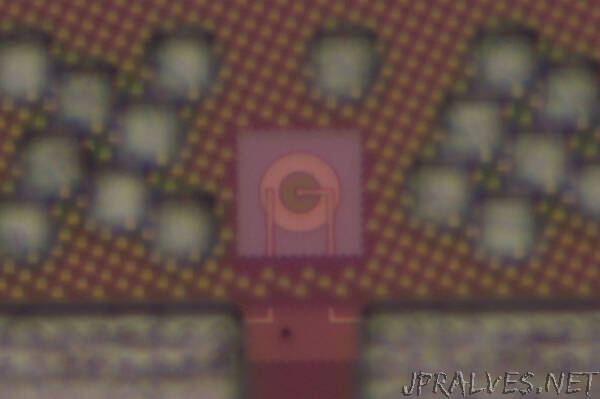
“The advance could cut production costs and reduce the size of microelectronics for sensing and communication.
nect LED technologies to a device’s computer chip.
The LED in your smartphone’s proximity sensor, for example, is made from III-V semiconductors, so called because they contain elements from the third and fifth columns of the periodic table. (Silicon is in the fourth column.) These semiconductors are more optically efficient than silicon — they produce more light from a given amount of energy. (You don’t see the light produced from the proximity sensor because it is infrared, not visible.)
And while the proximity sensor is a fraction of the size of the phone’s silicon processor, it adds significantly to the phone’s overall cost. “There’s an entirely different fabrication process that’s needed, and it’s a separate factory that manufactures that one part,” says Ram. “So the goal would be: Can you put all this together in one system?” Ram’s team did just that.
Xue designed a silicon-based LED with specially engineered junctions — the contacts between different zones of the diode — to enhance brightness. This boosted efficiency: The LED operates at low voltage, but it still produces enough light to transmit a signal through 5 meters of fiber optic cable. Plus, GLOBALFOUNDRIES manufactured the LEDs right alongside other silicon microelectronic components, including transistors and photon detectors. While Xue’s LED didn’t quite outshine a traditional III-V semiconductor LED, it easily beat out prior attempts at silicon-based LEDs.
“Our optimization process of how to make a better silicon LED had quite an improvement over past reports,” says Xue. He adds that the silicon LED could also switch on and off faster than expected. The team used the LED to send signals at frequencies up to 250 megahertz, indicating that the technology could potentially be used not only for sensing applications, but also for efficient data transmission. Xue’s team plans to continue developing the technology. But, he says, “it’s already great progress.”
Ram envisions a day when LED technology can be built right onto a device’s silicon processor — no separate factory needed. “This is designed in a standard microelectronics process,” he says. “It’s a really integrated solution.”
In addition to cheaper manufacturing, the advance could also improve LED performance and efficiency as electronics shrink to ever smaller scales. That’s because, at a microscopic scale, III-V semiconductors have nonideal surfaces, riddled with “dangling bonds” that allow energy to be lost as heat rather than as light, according to Ram. In contrast, silicon forms a cleaner crystal surface. “We can take advantage of those very clean surfaces,” says Ram. “It’s useful enough to be competitive for these microscale applications.”
“This is an important development,” says Ming Wu, an electrical engineer at the University of California at Berkeley, who was not involved with the research. “It allows silicon integrated circuits to communicate with one another directly with light instead of electric wires. This is somewhat surprising as silicon has an indirect bandgap and does not normally emit light.”
Silicon “occupies the crown in electronic devices” will continue its reign “without a doubt,” says Chang-Won Lee, an applied optics researcher at Hanbat National University, who also was not involved in the work. However, he agrees with Wu that this advance represents a step toward silicon-based computers that are less reliant on electronic communication. “For example, there is an optical CPU architecture that the semiconductor industry has been dreaming of. The report of silicon-based micro-LEDs shows significant progress in these attempts.”
Ram is confident that his team can continue finetuning the technology, so that one day LEDs will be cheaply and efficiently integrated into silicon chips as the industry standard. “We don’t think we’re anywhere close to the end of the line here,” says Ram. “We have ideas and results pointing to significant improvements.”
This research was supported by Singapore’s Agency for Science, Technology and Research, and by Kwanjeong Educational Foundation.”
